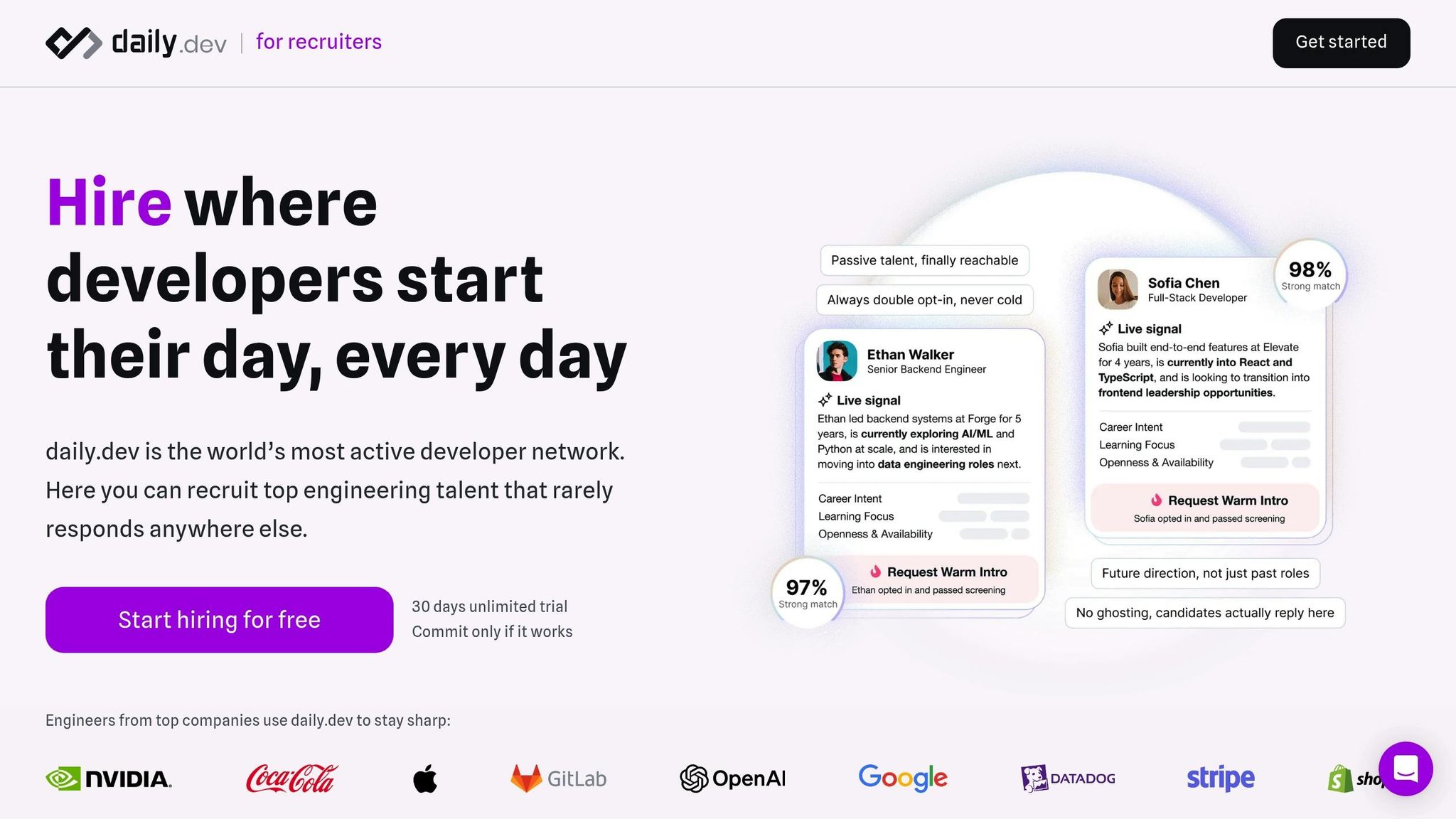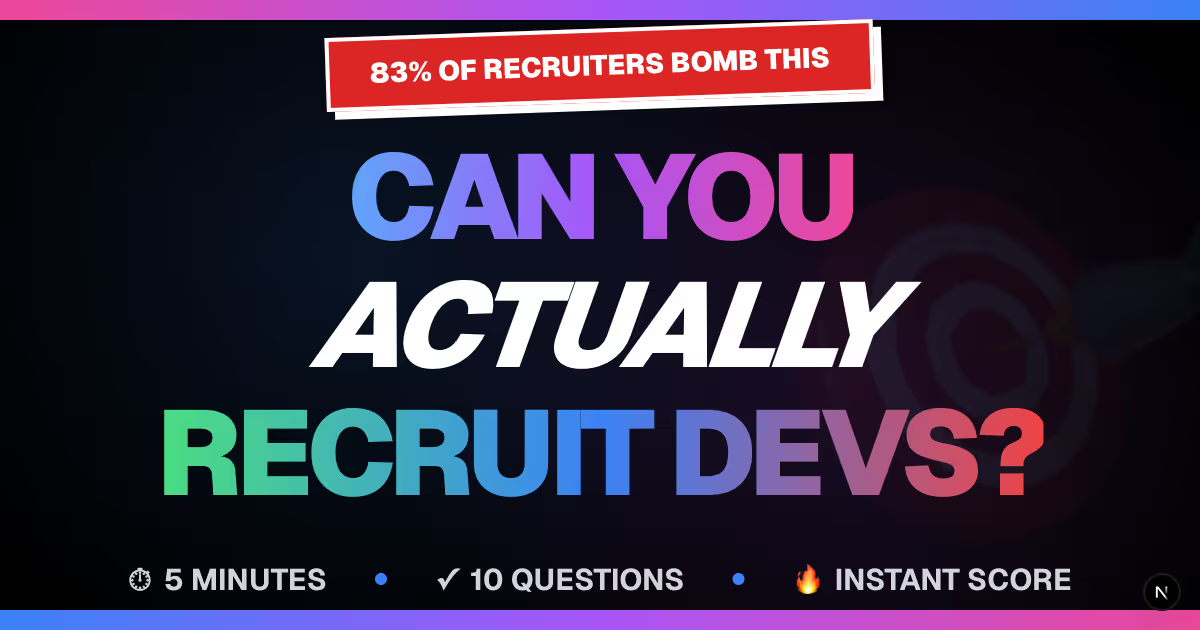


Passive candidates often overlook job postings due to lack of engagement, generic descriptions, and poor timing. Learn how to connect with them effectively.
Passive candidates, or professionals not actively job hunting, often ignore job postings for three main reasons:
- They don’t use job boards: Passive candidates are busy excelling in their current roles and spend their time in professional communities or reading industry updates - not browsing job listings.
- Generic job descriptions: Vague, buzzword-heavy postings fail to connect with their technical interests or career goals.
- Poor timing: These candidates aren’t actively seeking roles, so they miss outdated or irrelevant postings.
To engage passive talent, recruiters must shift from traditional methods and connect with candidates where they already spend time - on trusted platforms like daily.dev. This approach, combined with clear, tailored job briefs and warm introductions, can significantly improve response rates and build better connections.
Why Passive Candidates Ignore Job Postings
Passive Candidates Don't Browse Job Boards
Reaching passive candidates comes with its own set of challenges, and one of the biggest hurdles is their lack of presence on traditional job boards. These professionals are often content in their current roles, dedicating their time to activities like reading technical articles, honing their skills, or participating in professional communities. This explains why job boards frequently fail to connect with passive talent. Instead of being an engaging platform, these boards function more like databases for active job seekers, leaving little appeal for those not actively searching. The gap between how job boards operate and what passive candidates engage with is a major reason they remain out of reach.
Generic Job Descriptions Don't Connect
On the rare occasion that passive candidates do stumble upon a job posting, they’re often turned off by descriptions that feel generic and overloaded with buzzwords. These postings lack the technical depth and clarity that would resonate with them. Developers, in particular, have voiced their frustrations about this issue. Nimrod Kramer from daily.dev summed it up well:
"We asked developers what's broken in hiring. Their answers: vague roles."
Many job postings fail to include specific details, such as the hiring manager’s must-haves or unique requirements that would help candidates assess whether the role aligns with their expertise and goals. Without this context, it’s easy for candidates to misinterpret the role, leading to mismatched expectations for everyone involved - recruiters, hiring managers, and candidates alike.
Timely Visibility Matters
Timing is another factor that works against traditional job postings. Passive candidates don’t refresh job boards daily like active seekers do. By the time they come across a posting, it’s often outdated or irrelevant. Their openness to new opportunities also depends heavily on their current priorities and workload. Platforms like daily.dev offer a solution by keeping opportunities visible through regular engagement with developers. With 90% of daily.dev’s network engaging exclusively on the platform, it provides a consistent way to stay on their radar and address the timing problem effectively.
Job Bank VC: How to Recruit Passive Candidates Effectively | 01.10.2025
The Cost of Missing Passive Talent
Passive candidates don’t browse job boards or respond to generic job postings, and ignoring them can have serious consequences. Companies that overlook this group risk falling behind in attracting top talent and maintaining a competitive edge in the market.
Limited Access to Top Talent
Bypassing passive candidates means shutting the door on some of the most skilled professionals. Nearly half of daily.dev’s network consists of senior developers, many of whom possess the leadership qualities and technical expertise that companies desperately need but often fail to reach through standard hiring methods.
The challenge is clear: most passive candidates simply don’t engage with traditional outreach. Relying solely on active job seekers creates a bottleneck, especially for specialized roles that demand niche skills. Senior developers with deep domain expertise rarely need to actively look for jobs, making them nearly invisible to conventional recruitment strategies.
Slower Hiring and Increased Competition
Ignoring passive talent also drags out the hiring process. A smaller pool of candidates means it takes longer to find the right fit. On the other hand, engaging passive candidates through personalized, double opt-in introductions can significantly improve response rates - often exceeding 85–90%. This higher engagement not only speeds up initial conversations but also shortens the overall hiring timeline.
Reduced Opportunities for Diversity
Focusing solely on active candidates isn’t just a time issue - it also limits diversity. Passive candidates represent a global network that spans across markets and cultures. Traditional recruitment methods often favor local or regional talent pools, which can result in a less diverse workforce. By missing out on passive talent, organizations may inadvertently restrict their access to a broader range of perspectives and experiences.
sbb-itb-d1e6221
Why Job Postings Don't Work for Passive Candidates
Traditional job postings are built to attract active job seekers, but they often miss the mark when it comes to engaging skilled passive candidates. This gap highlights the limitations of conventional job boards and static listings, especially in reaching out to professionals who aren’t actively searching for new opportunities.
Job Boards Cater to Active Seekers
Job boards are designed with active candidates in mind. According to daily.dev, a staggering 90% of developers ignore outreach on these platforms. Why? Because these boards function more like static directories than vibrant, interactive communities where developers actually spend their time.
Complicated Applications Push Candidates Away
For passive candidates, unclear job descriptions and missing details are a big turn-off. They’re not going to invest time trying to figure out if a role is worth their attention. Add in lengthy screening processes, and it’s no wonder they lose interest. These issues create a disconnect between what recruiters expect and what developers are willing to engage with.
Lack of Connection to Developer Communities
Traditional job postings fail to tap into the online spaces where developers are most active. Developers gravitate toward communities that provide insights on the latest tools and trends. Platforms like daily.dev, which logs an incredible 1 billion sessions each day, are where developers thrive. Without integrating into these trusted, interactive environments, job postings miss a huge opportunity to connect with passive talent.
"Developers don't live in databases, they live here" - daily.dev Recruiter
How to Engage Passive Developers
Reaching passive developers effectively means connecting with them on platforms they already trust, rather than relying on random job postings that often go unnoticed. Let’s dive into where developers spend their time and how to engage with them in meaningful ways.
Meet Developers Where They Are
The key to engaging passive developers is to interact with them in spaces they already value. Developers don’t typically hang out on job boards in their free time. Instead, they’re active on platforms that help them stay updated on tech trends, learn new skills, and network with peers.
One standout platform is daily.dev, a hub that’s become a part of many developers’ daily routines. With over 1 billion sessions and 1 in 50 developers actively using it, this platform is a gathering place for passive talent. What makes it especially effective is the trust developers place in it.
"Developers come to daily.dev every day to stay sharp on tools, technologies, and trends. And they trust this environment far more than traditional social media platforms - which is why they actually reply here."
This trust creates a huge difference in engagement. While most developers ignore outreach on traditional platforms, they’re far more likely to respond when approached within trusted, professional communities. In fact, the same developers who reject cold messages elsewhere are often open to career conversations in these trusted spaces.
How daily.dev Recruiter Makes a Difference

daily.dev Recruiter taps into this trusted environment to create warm, double opt-in introductions that respect developers’ time and preferences.
Here’s how it works: job opportunities appear directly within the daily.dev platform, where developers are already spending time. Each role is presented as a concise, developer-friendly brief that provides all the context upfront. This allows developers to quickly determine if the opportunity aligns with their interests before deciding to engage.
The platform’s success lies in the quality of engagement. Early cohorts have seen reply rates consistently exceed 85-90%. Why? Because developers aren’t being chased - they’re choosing to engage after reviewing the role.
"Every intro comes from a developer who reviewed your role and chose to engage - not someone you had to chase."
Another advantage of daily.dev Recruiter is its insights into developers’ skills, interests, and career goals. These insights go far beyond what’s available on resumes or profiles, enabling tailored matches that feel personal and relevant.
Best Practices for Reaching Passive Developers
To connect with passive developers effectively, follow these steps:
- Craft job briefs that speak to developers’ technical interests. Avoid generic buzzwords and focus on the specific technologies, challenges, and growth opportunities the role offers. Highlight details like the tech stack, the problems they’d solve, and the impact they could make.
- Be transparent about everything. Share clear, detailed information about compensation, benefits, team structure, and company culture. Developers are more likely to engage when they have the full picture upfront, avoiding mismatched expectations later.
- Use developer-focused platforms. Platforms like daily.dev, where 40% of users are senior contributors and leaders, provide access to the kind of talent that’s hard to reach elsewhere. Engaging them in spaces they already trust makes your outreach feel relevant instead of intrusive.
- Prioritize warm introductions. Double opt-in connections ensure that every conversation starts with mutual interest. This approach respects developers’ preferences and significantly improves response rates while setting a positive tone for future interactions.
Passive developers are cautious about where they invest their time. By providing the right context in a trusted environment, and being upfront about the details, you can turn passive candidates into some of the most engaged prospects in your hiring pipeline.
Conclusion: Reaching Passive Developer Talent
Reaching passive candidates isn’t just a matter of refining job boards or crafting better job descriptions. It’s about rethinking how we approach developer recruitment altogether. Traditional methods often assume developers are actively hunting for new opportunities, but that’s rarely the case.
Take this for example: 90% of developers on daily.dev ignore outreach that comes from outside the platform. This isn’t because they’re hard to reach - it’s because they want to be approached in ways that align with how they already engage professionally. Meeting developers where they are, on platforms they trust, is the key.
Developer-focused strategies tap into this trust, transforming regular interactions into meaningful career opportunities. When developers log into daily.dev, they’re not just browsing - they’re investing in their growth. They’re reading about emerging technologies, learning from peers, and staying updated on industry trends. In this context, career conversations feel natural, not intrusive.
This trust-driven approach doesn’t just build better relationships - it also delivers results. Warm, double opt-in introductions on platforms like daily.dev see reply rates soar to 85–90%. It’s a recruitment process that values developers’ time and preferences while giving employers access to talent that’s often out of reach through traditional methods.
As Nimrod Kramer of daily.dev puts it:
"Trust is the currency of modern recruiting" - Nimrod Kramer, daily.dev
And the talent available in these trusted spaces is top-tier. With 40% of the daily.dev network made up of senior professionals, these platforms provide access to highly skilled individuals who are unlikely to respond to generic outreach.
The takeaway? Recruiters need to move away from outdated tactics like cold emails and database chasing. Instead, they should focus on building genuine connections in the communities where developers already spend their time. This shift doesn’t just improve hiring outcomes - it creates a smoother, more respectful experience for everyone, from the first introduction to the final offer.
Passive candidates aren’t unreachable - they just need to be engaged on their terms. By meeting developers in their space, recruiters can unlock opportunities that were previously out of reach.
FAQs
How can recruiters connect with passive candidates who aren’t actively job hunting?
Recruiters can build strong connections with passive candidates by reaching out to them in the places they naturally spend their time. Tools like daily.dev Recruiter allow employers to connect with developers while they’re immersed in activities like reading, learning, and engaging with their professional network.
This method helps establish trust by facilitating warm, double opt-in introductions to pre-screened developers who are genuinely interested in exploring opportunities. Instead of relying on impersonal cold outreach, recruiters can focus on forming meaningful relationships with candidates who are more inclined to engage and consider roles that truly align with their skills and interests.
How can you write job descriptions that attract passive candidates?
Job descriptions aimed at passive candidates should be clear, engaging, and speak directly to their interests. Highlight what sets the role apart - whether it’s exciting growth opportunities, meaningful projects, or a workplace culture that stands out. Steer clear of generic phrases and instead focus on specific details that align with their career aspirations.
To make these opportunities feel personal and relevant, consider tools like daily.dev Recruiter. This platform connects employers with developers who are already active and interested in exploring valuable opportunities, ensuring every interaction feels purposeful and worthwhile.
Why is it important for companies to connect with passive candidates when hiring?
Reaching out to passive candidates is a crucial step in securing top talent. These professionals often have the skills and experience that companies are looking for, even though they’re not actively seeking new opportunities. By connecting with them in spaces they already frequent, businesses can access a broader, high-caliber talent pool that might otherwise remain untapped.
Tools like daily.dev Recruiter simplify this process by allowing companies to engage with passive, pre-qualified developers in a way that feels natural and inviting. This method not only fosters trust but also ensures that candidates show genuine interest in the role. The result? A more efficient hiring process and stronger, more meaningful hires.
Related Blog Posts








